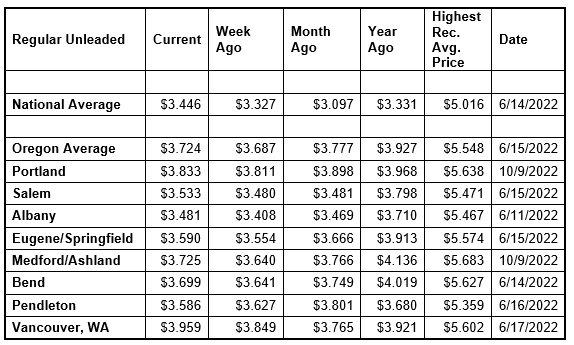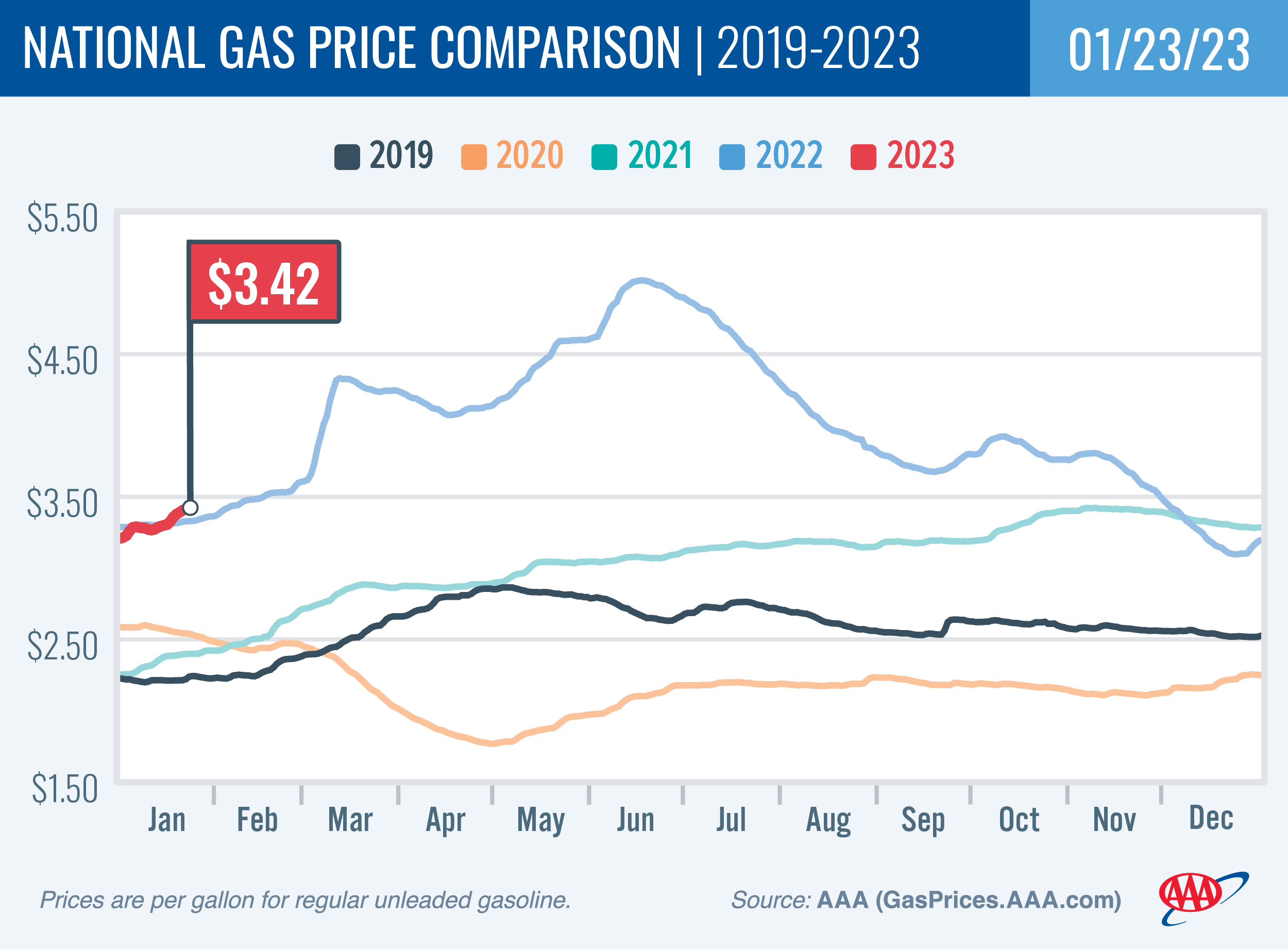Oregon has fifth-smallest weekly gain, third-largest monthly drop and second-largest yearly decline in the nation
PORTLAND, Ore., – Drivers appear to be taking advantage of milder winter weather across much of the country by fueling up and driving more. The increase in demand for gasoline and more expensive crude oil have pushed pump prices higher. For the week, the national average for regular unleaded jumps 12 cents to $3.44. The Oregon average adds four cents to $3.72. This is the fifth-smallest weekly gain for a state in the nation.

“The relatively mild winter weather and the cost of crude oil rising above $80 per barrel have put upward pressure on pump prices for now. If demand remains strong, it’s likely we’ll see continued upward momentum in pump prices through the week,” says Marie Dodds, public affairs director for AAA Oregon/Idaho.
Crude oil is trading around $80 per barrel today. This month, West Texas Intermediate has ranged between about $73 and $82 bbl. and was $83 a year ago. Crude reached recent highs of $123.70 on March 8, 2022, and $122.11 per barrel on June 8, 2022. The all-time high for WTI crude oil is $147.27 in July 2008.
Crude oil prices tend to rise in response to positive economic news as countries with growing economies tend to consume more oil than countries with shrinking economies.
Crude prices rose dramatically leading up to and in the first few months of Russia’s invasion of Ukraine. Russia is one of the world’s top oil producers and its involvement in a war causes market volatility, and sanctions imposed on Russia by the U.S. and other western nations resulted in tighter global oil supplies. Oil supplies were already tight around the world as demand for oil increased as pandemic restrictions eased.
Crude oil is the main ingredient in gasoline and diesel, so pump prices are impacted by crude prices on the global markets. On average, about 56% of what we pay for in a gallon of gasoline is for the price of crude oil, 20% is refining, 11% distribution and marketing, and 14% are taxes, according to the U.S. Energy Information Administration.
Demand for gasoline in the U.S. rose from 7.56 million to 8.05 million b/d last week. This compares to 8.22 million b/d a year ago. Meanwhile, total domestic gasoline stocks increased by 3.5 million bbl to 230.3 million bbl. for the week ending January 13. If demand remains strong, pump prices are likely to continue to climb this week.
Quick stats
Oregon is one of 48 states and the District of Columbia with higher prices week-over-week. Colorado (+27 cents) has the largest weekly jump, followed by Tennessee (+21 cents), and Georgia (+20 cents). Hawaii (-4 cents) and Indiana (-4 cents) are the only two states with weekly declines.
Hawaii ($4.95) is the state with the most expensive gas in the nation for the ninth week in a row. California ($4.45) is second and Washington $4.07 is third. These are the only three states with averages at or above $4 a gallon. This week 47 states and the District of Columbia have averages in the $3-range. No states have averages below $3 a gallon.
The cheapest gas in the nation is in Texas ($3.07) and Kansas ($3.10). For the 106th week in a row, no state has an average below $2 a gallon.
The difference between the most expensive and least expensive states is $1.88 this week compared to $2.06 last week so the gap is shrinking.
Oregon is one of only four states with lower prices now than a month ago. The national average is 35 cents more and the Oregon average is five cents less than a month ago. Oregon has the third-largest monthly decrease in the nation. Hawaii (-11 cents) and Idaho (-7 cents) have the largest monthly declines. Colorado (+87 cents) and Georgia (+59 cents) have the largest monthly gains.
Oregon is one of only seven states with lower prices now than a year ago. The national average is 12 cents more and the Oregon average is 20 cents less than a year ago. This is the second-largest yearly drop in the nation. Montana (-21 cents) has the largest year-over-year decline. Hawaii (+60 cents) and Ohio (+42 cents) have the biggest year-over-year jumps.
West Coast
The West Coast region continues to have the most expensive pump prices in the nation with six of the seven states in the top 10. This is typical for the West Coast as this region tends to consistently have fairly tight supplies, consuming about as much gasoline as is produced. In addition, this region is located relatively far from parts of the country where oil drilling, production and refining occurs, so transportation costs are higher. And environmental programs in this region add to the cost of production, storage and distribution.
| Rank | Region | Price on 1/24/23 |
| 1 | Hawaii | $4.95 |
| 2 | California | $4.45 |
| 3 | Washington | $4.07 |
| 4 | Nevada | $3.95 |
| 5 | Alaska | $3.75 |
| 6 | Oregon | $3.72 |
| 7 | Pennsylvania | $3.71 |
| 8 | Colorado | $3.69 |
| 9 | District of Columbia | $3.63 |
| 10 | Illinois | $3.59 |
As mentioned above, Hawaii is the most expensive state in the nation, with California, Washington, Nevada, Alaska, and Oregon rounding out the top six. Arizona is 14th. Oregon is sixth most expensive for the third week in a row.
All states in the West Coast region are seeing small to moderate changes for the week. Arizona (+8 cents) and Washington have the largest weekly increases in the region. Hawaii (-4 cents) is the only state in the region with a weekly decline.
The refinery utilization rate on the West Coast fell from 84.4% to 80.3% for the week ending January 13. This rate has ranged between about 76% to 92% in the last year.
According to EIA’s latest weekly report, total gas stocks in the region edged up from 34.07 million bbl. to 34.39 million bbl.
Oil market dynamics
Crude prices rose at the end of last week due to increased market optimism that crude demand may be more robust than expected this year. In particular, the market believes that the re-opening of China’s economy, despite high coronavirus infection rates, will help to bolster global crude demand, while supporting elevated prices. For this week, crude prices could continue to climb if ongoing market optimism persists.
At the close of Friday’s formal trading session, WTI increased by $1.03 to settle at $81.64. At the close of Monday’s formal trading session, WTI slipped three cents to close at $81.61. Today crude is trading around $80, compared to $80 a week ago. Crude prices are about $4 less than a year ago.
Drivers can find current gas prices along their route with the free AAA Mobile app for iPhone, iPad and Android. The app can also be used to map a route, find discounts, book a hotel and access AAA roadside assistance. Learn more at AAA.com/mobile.

Diesel
For the week, the national average adds four cents to $4.64 a gallon. The record high is $5.816 set on June 19. The Oregon average adds half a cent to $4.73. The record high is $6.47 set on July 3. A year ago the national average for diesel was $3.67 and the Oregon average was $4.09.
Find current fuel prices at GasPrices.AAA.com.
AAA news releases, high resolution images, broadcast-quality video, fact sheets and podcasts are available on the AAA NewsRoom at NewsRoom.AAA.com.
Find local news releases at https://oregon.aaa.com/community/media/media-contacts.html


